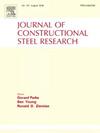Experimental investigation on cold-formed stainless steel stiffened C-sections under localized interior-two-flange loading
IF 4
2区 工程技术
Q1 CONSTRUCTION & BUILDING TECHNOLOGY
引用次数: 0
Abstract
This paper presents a test program to study the web crippling behavior of cold-formed stainless steel stiffened C-sections. A total of 51 specimens having different stainless steel types, web slenderness ratios, flange conditions and bearing lengths were tested under interior-two-flange (ITF) load case codified in American Specification ASCE/SEI 8. The failure modes, load-displacement relationships and web crippling capacities of specimens with unfastened and fastened flanges were obtained and fully reported. It is found that the fastened flanges could significantly enhanced the web crippling capacities of the C-sections, especially for those with high web slenderness ratios. The test results showcased the specimen lengths had significant effects on the web crippling capacities of C-sections under ITF load case. The obtained experimental web crippling capacities were compared with the nominal predictions calculated by the American and European design provisions. It is indicated that the current American design provisions are generally unconservative and unreliable for the cold-formed stainless steel stiffened C-sections under ITF load case, except for austenitic stainless steel sections with flanges fastened. By contrast, the European design provisions are generally quite conservative in predicting the web crippling capacities. The reasons of unsatisfactory predictions by the codified design rules are discussed.
局部内部两翼缘加载条件下冷弯不锈钢加劲 C 型钢的实验研究
本文介绍了研究冷弯不锈钢加劲 C 型钢腹板脆化行为的测试程序。在美国规范 ASCE/SEI 8 规定的内部两翼缘(ITF)荷载情况下,共测试了 51 个具有不同不锈钢类型、腹板细长比、翼缘条件和支承长度的试样。获得并全面报告了未紧固和紧固法兰试样的破坏模式、荷载-位移关系和腹板瘫痪能力。试验发现,紧固翼缘能显著提高 C 型截面的腹板抗折能力,尤其是对于腹板细长比高的截面。试验结果表明,在 ITF 载荷情况下,试样长度对 C 型截面的腹板脆化能力有显著影响。实验得出的腹板脆化能力与美国和欧洲设计规定计算得出的名义预测值进行了比较。结果表明,对于在 ITF 载荷情况下的冷弯型钢加劲 C 型钢,美国现行设计规定通常是不严谨和不可靠的,有法兰紧固的奥氏体不锈钢型钢除外。相比之下,欧洲的设计规定在预测腹板脆化承载力时通常比较保守。本文讨论了成文设计规则预测结果不尽人意的原因。
本文章由计算机程序翻译,如有差异,请以英文原文为准。
求助全文
约1分钟内获得全文
求助全文
来源期刊

Journal of Constructional Steel Research
工程技术-工程:土木
CiteScore
7.90
自引率
19.50%
发文量
550
审稿时长
46 days
期刊介绍:
The Journal of Constructional Steel Research provides an international forum for the presentation and discussion of the latest developments in structural steel research and their applications. It is aimed not only at researchers but also at those likely to be most affected by research results, i.e. designers and fabricators. Original papers of a high standard dealing with all aspects of steel research including theoretical and experimental research on elements, assemblages, connection and material properties are considered for publication.
 求助内容:
求助内容: 应助结果提醒方式:
应助结果提醒方式:


